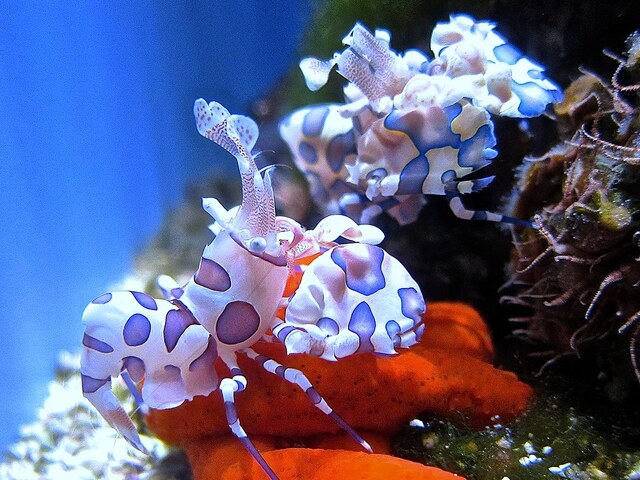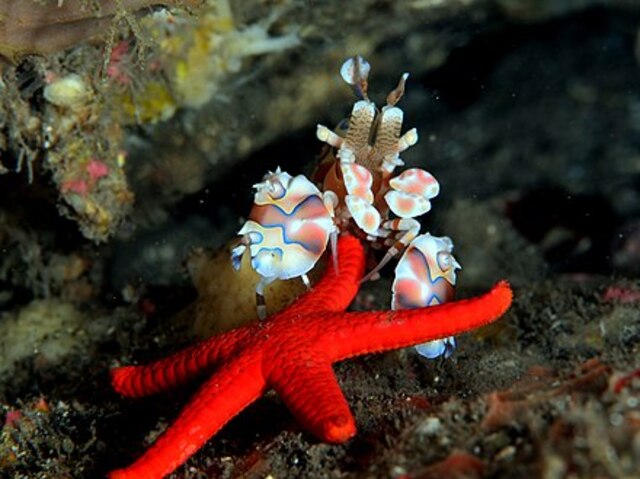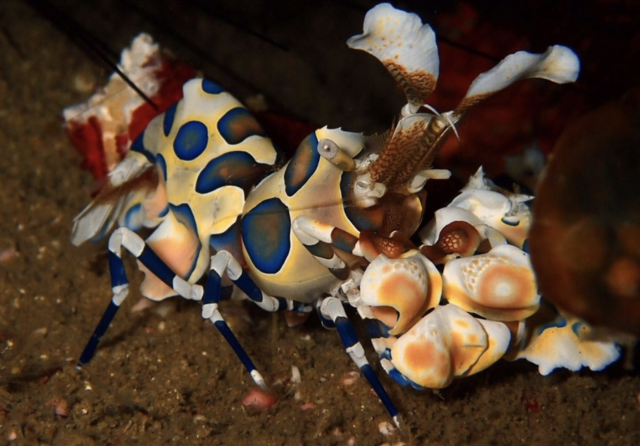The Harlequin Shrimp (Hymenocera picta), ( also known as the star shrimp , VIP shrimp , harlequin shrimp ,Harlequin Dancing Shrimp,clown shrimp , and dancing shrimp ) , is a visually striking marine crustacean native to the tropical waters of the Indo-Pacific. Renowned for its bold patterns and unique predatory behavior, this shrimp has become a focus of ecological research and marine enthusiasts alike.
Kingdom: Animalia
Phylum: Arthropoda
Class: Malacostraca
Order: Decapoda
Family: Gnathophyllidae
Genus: Hymenocera
Species: Hymenocera picta
The Harlequin Shrimp was first classified in the 19th century and has since been extensively studied for its remarkable coloration and behavior. Historically, it was considered a single species, but modern research suggests two potential subspecies:
Hymenocera picta: Found in the Central and Eastern Pacific, with purple spots bordered by yellow.
Hymenocera elegans: Found in the Indian Ocean and Western Pacific, featuring brownish spots with blue borders.
These differences highlight the shrimp's adaptability to diverse habitats (Mariscal, 1974; Hochberg, 1988).

Harlequin Shrimp are renowned for their vibrant, patterned exoskeletons. Their bodies are primarily cream or white, adorned with purple, pink, or brown spots. These colors vary slightly depending on the specific region of origin. Their flat, paddle-like claws and prominent, fan-shaped antennae contribute to their unique appearance.
Adults typically measure 3 to 5 cm (1.2 to 2 inches) in length, with males slightly smaller than females. Their lightweight bodies are perfectly suited for navigating coral reef environments.
In the wild, Harlequin Shrimp generally live for 1 to 2 years. However, in well-maintained aquariums, they can survive up to 3 years.
The Harlequin Shrimp is found throughout the tropical Indo-Pacific region, including the coral reefs of the Philippines, Indonesia, Australia, and Hawaii. These shrimp inhabit depths of 5 to 30 meters (16 to 98 feet), preferring warm, clear waters with temperatures ranging from 22°C to 28°C (72°F to 82°F). They thrive in reef crevices, under coral ledges, or near their primary prey—sea stars (McDonald & Carthy, 2000).
Harlequin Shrimp are typically found in pairs, forming strong monogamous bonds. These pairs work together to hunt sea stars, using teamwork to immobilize and feed on their prey. Despite their relatively slow movement, they are highly effective predators.
Harlequin Shrimp are obligate carnivores, feeding almost exclusively on sea stars. Their diet includes various species, such as the Crown-of-Thorns Starfish (Acanthaster planci). They employ a unique hunting strategy, flipping sea stars over to access their vulnerable underside before consuming the soft tissue and tube feet (Burgess & Hatcher, 1991).
Occasionally, they may consume sea urchin tube feet when food is scarce, but this is rare. The shrimp extract toxins from their prey, which makes them less palatable to potential predators (Hochberg, 1988).

Harlequin Shrimp are oviparous, with females producing between 100 and 5,000 eggs per clutch. The eggs are carried under the female’s abdomen until they hatch. Newly hatched larvae are planktonic, eventually settling into reef environments as they mature (Mariscal, 1974).
The Harlequin Shrimp is not currently listed as endangered. However, its dependence on coral reefs and sea stars makes it vulnerable to habitat destruction, overfishing, and climate change (Hochberg, 1988).
In some regions, populations are declining due to coral reef degradation and overcollection for the aquarium trade. Increased sea temperatures and ocean acidification also threaten their habitats (Burgess & Hatcher, 1991).
Main Threats: Coral reef destruction, climate change, pollution, and overfishing for aquariums.
Natural Predators: Large crustaceans and predatory fish. However, their acquired toxicity deters most predators.
Marine protected areas (MPAs) and reef restoration initiatives are crucial for safeguarding Harlequin Shrimp habitats.
Sustainable aquarium trade practices, such as captive breeding programs, help reduce wild population pressures.
Harlequin Shrimp play a vital role in coral reef ecosystems by preying on sea stars, especially the invasive Crown-of-Thorns Starfish. This behavior helps prevent overpopulation of these starfish, which can devastate coral reefs by feeding on coral polyps (McDonald & Carthy, 2000).

The Harlequin Shrimp’s striking appearance makes it highly sought after in the aquarium trade. While it is challenging to care for due to its specialized diet, it remains popular among marine hobbyists for its aesthetic value. Additionally, its role in scientific studies on predator-prey dynamics adds to its importance.
| Species | Distribution | Coloration | Diet | Key Differences |
|---|---|---|---|---|
| Harlequin Shrimp (H. picta) | Central & Eastern Pacific | Purple spots with yellow edges | Sea stars | Paddle-like claws, vibrant colors |
| Hymenocera elegans | Indian & Western Pacific | Brown spots with blue edges | Sea stars | Slightly darker coloration |
The Harlequin Shrimp (Hymenocera picta) is more than just a visually stunning marine animal; it is a critical component of coral reef ecosystems. By controlling sea star populations, it helps maintain reef health and biodiversity. However, its survival is intricately linked to the preservation of its habitat. Through increased conservation efforts and responsible practices, we can ensure that this beautiful and ecologically significant species continues to thrive.
References: Mariscal, 1974; Hochberg, 1988; Burgess & Hatcher, 1991; McDonald & Carthy, 2000.
animal tags: Gnathophyllidae
We created this article in conjunction with AI technology, then made sure it was fact-checked and edited by a Animals Top editor.